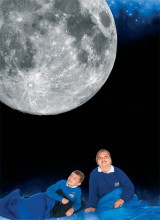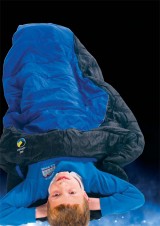What better way to launch a topic on space than with a Stargazers Sleepover, asks Jonathan Lear
Children are naturally fascinated by space, the stars and planets and this topic allows them to explore the great unknown for themselves by harnessing their creative thinking in preparation for a very special event.
There won’t be many primary aged children out there that wouldn’t be hugely excited by the prospect of a sleepover with their friends. When you throw in the fact that this sleepover will be at school, the excitement is likely to double.
Staying up all night, midnight feasts, chatting to friends, seeing the school after dark; what’s not to like? If you’re slightly older than 10, this may read like a list from hell, but sometimes the odd sacrifice is worth it to give the children an experience that they’ll remember for years.
 In the weeks leading up to the event, there is a certain amount of planning and preparation needed. The children will all need a letter well in advance that outlines the Stargazers Sleepover event. Along with the usual permission bits, they’ll need to know details like start time (Blast off!), what they need to bring with them, and most importantly, the time they need to be collected the following morning! You might also consider asking the children for a small contribution that would help fund the food and refreshments that are to be provided.
In the weeks leading up to the event, there is a certain amount of planning and preparation needed. The children will all need a letter well in advance that outlines the Stargazers Sleepover event. Along with the usual permission bits, they’ll need to know details like start time (Blast off!), what they need to bring with them, and most importantly, the time they need to be collected the following morning! You might also consider asking the children for a small contribution that would help fund the food and refreshments that are to be provided.
In terms of practically catering for 30 sleeping (optimistic, I know) children, they need to be as comfortable as possible. Most schools will have those heavy duty foam PE mats that are used for gymnastics; these make excellent mattresses and are surprisingly comfortable when softened a little by sleeping bags and pillows. Ideally, the children will need one mat each, if this is a problem, there’s likely to be a neighbouring school that would happily lend the extras for the duration of the event. The children will all be together, so unless you have a very big classroom, you’ll need to commandeer the school hall. The only other preparation that needs to be done well inadvance is the recruitment of other staff in school to help you out. There will be a minimum number of adults that you need, however, the more the merrier, and if people in school offer I would snatch their hand off.
With the practical sides of things dealt with, it’s the children that will shape the rest of the preparations. Depending on how you wish to structure the work, you might begin anywhere up to a half term before the event. Alternatively, you could set aside a week or couple of weeks beforehand and work on the preparations more intensively.
Whichever option you go for, the children’sideas will be central. Introduce the Stargazers Sleepover event to the children. When you’ve peeled them off the walls, ask them what they think the theme will be. Discuss the kind of things that need to be done – we’ll need to decorate the space, what about food? What games or activities could we have? What shall we do when it gets dark? After giving them these prompts, let them work in groups to generate ideas.
When taking feedback, record children’s ideas and highlight the elements of learning that they’ll need in order to be successful. If, for example, they want to decorate the hall with pictures or models of planets, they’ll need to know about planet names, relative sizes, special features etc. If they mention food (it doesn’t usually take long to crop up), do they know what astronauts eat? How could they find out?
 Having collected their initial thoughts, the class can be divided up into smaller teams to work on a specific part of the event. Team 1 might be in charge of activities and games; Team 2, food; Teams 3 & 4, decorating the venue.
Having collected their initial thoughts, the class can be divided up into smaller teams to work on a specific part of the event. Team 1 might be in charge of activities and games; Team 2, food; Teams 3 & 4, decorating the venue.
As they are working, your role will be to guide children through particular elements of learning by prompting them with further questions. For example, the team that is developing games and activities might be prompted to look into rocket propulsion, perhaps a rocket race could be organised? (There are lots of different ways of achieving this but the old favourite of releasing a balloon rocket along a length of string usually works well.) The groups that are decorating the venue might decide to divide the hall into zones based on planets, if the sun was in the corner of the hall, where would the Mars zone be? Earth? Jupiter? Food could be space themed and prepared in part by the children, they can even try astronaut food for themselves. (Try astronautfood.co.uk or Hawkin’s Bizarre for freeze dried Neapolitan ice-cream.)
This form of learning can be hugely valuable; the children often learn a whole lot more than we could have originally planned for in a more structured unit with predetermined learning objectives. We will obviously have certain things that we want them to experience or learn, but thefreedom of this kind of work allows space for the children’s own creative thinking to take them in directions that we may never have considered.
With preparations and excitement levels at a peak, it’s time for the main event. If the children have done a good job, there’ll be very little left for you to do. Food may need preparing; timings sorted, but to be honest, the more responsibility you’ve handed over to the children the better. If you’re lucky, you’ll get a perfectly clear night. If so, the children can be outside for some real stargazing. If it’s cloudy, there’s not a lot that can be done, although it might be worth investing in a Planetarium Projector which will throw images of the night sky onto the ceiling of the hall. (Prices range from about £25 up to £70).
 After the food has been eaten, and games have been played, gather the children in front of a big screen and finish the night with a movie (this could be any space related film, but for me, E.T takes some beating). And if you’re after a truly magical end to the experience, I would consider just how many of the children have seen the dawn of a new day. If you’re feeling brave, wake them up to watch the sunrise with a comforting mug of hot chocolate, a great opportunity for learning at its most powerful.
After the food has been eaten, and games have been played, gather the children in front of a big screen and finish the night with a movie (this could be any space related film, but for me, E.T takes some beating). And if you’re after a truly magical end to the experience, I would consider just how many of the children have seen the dawn of a new day. If you’re feeling brave, wake them up to watch the sunrise with a comforting mug of hot chocolate, a great opportunity for learning at its most powerful.
Let pupils lead, but take care to structure their learning…
It should be left to the children to decide what happens during the Stargazers Sleepover, but it’s down to the teacher to record their ideas and draw attention to the learning that needs to take place. For example:
• You might prompt children to look into rocket propulsion, perhaps a rocket race could be organised?
•If children decorate the hall, they might decide to divide it into zones based on planets. If the sun was in the corner of the hall, where would the Mars zone be? Earth? Jupiter?
• Food could be space themed and prepared in part by the children. They can even try astronaut food for themselves (try astronautfood.co.uk).
• You might be able to borrow an iphone or an ipad, in which case there are some great apps which enable you to see which stars, constellation and even satellites you’re looking at in real time.
Behaviour management: choosing the right words
Behaviour Management
Teaching Mandarin via video conference
Languages
8 Ways To Get Your Class Drawing
Ace-Art-And-Design
